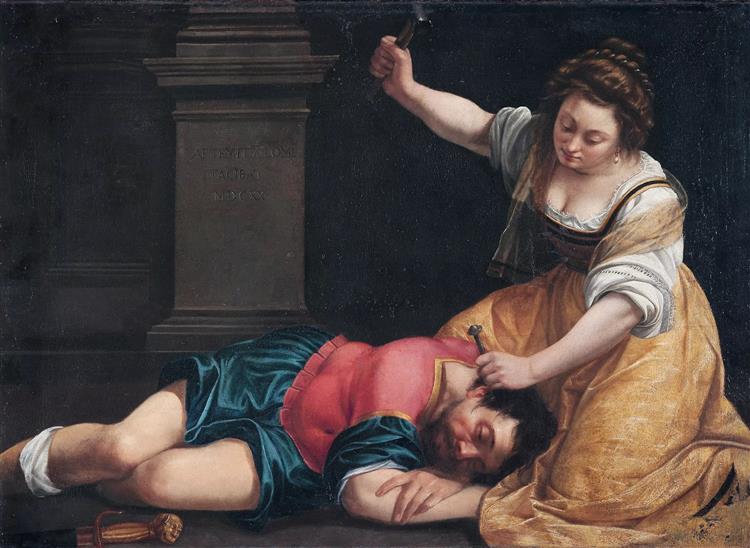Artemisia Gentileschi - Tenebrism and Counter-Reformation in the Baroque Era
The Baroque Era (roughly between the 17th and 18th centuries), followed the Renaissance and opened a new genre of art. After the Reformation that occurred during the Renaissance in which people began to distance themselves from the Catholic church, the church began a counter-reformation to regain it's following. Rather than the idealized images of the Renaissance period, the church began coveting and commissioning more realistic, emotion-provoking pieces of art. The technique of tenebrism emerged. Focusing on a sharp contrast between the dark and the light of a painting, this technique allowed the darkness of a painting to become more noticeable compared to paintings popular during the Renaissance. With the looming darkness emerged darker imagery being portrayed. Part of the Counter-Reformations efforts in inspiring people to return to the church was presenting jaw-dropping imagery of biblical events. Because conquering sin can be seen as a messy task.

A painting that stands out to me from this era is Jael and Sisera (Italy, 1620) by Italian artist Artemisia Gentileschi. Though Gentileschi was born in Rome, where she studied under her father, the famous Orazio Gentileschi, she found most of her success in Naples. Due to the Thirty-Years war, Naples had rebelled against it's Spanish ruling and officially established the Neapolitan Republic for a period of time. While Rome didn't care much for a female artist, and after an infamous event, Artemisia moved to Naples continuing her art career. There she was commission by the church for biblical scenes and her artwork was well respected despite her gender in a male dominated industry.
This piece shows the gruesome imagery that was in demand during this period as well as being a perfect example of how this era showcased movement and action in artwork. While the darkness in this piece is not as encapsulating as some of her other works, we can still see the technique of tenebrism. The dark background and strong shadows make it feel as if the characters are pushed out of the canvas. The painting also displays motion and makes you feel as if the hammer is going to come down at any moment. Detail in the fabrics and shadows of the skin produce a hyper-realistic affect, differing from the more idealistic realism of the Renaissance.
I'm incredibly inspired and moved by Gentileschi's story and artwork. Though she has some gruesome works, I would love to have a great deal of them displayed around my house someday. Her artwork and style truly stands out, it's no wonder she is such a well-known and respected artist of this era.
Sources:
Image - https://www.wikiart.org/en/artemisia-gentileschi/yael-et-sicera-1620
“Schilb Antiquarian.” Schilbantiquarian.com, 2025, www.schilbantiquarian.com/product/1665-naples-revolt-of-1647-spain-thirty-years-war-raimond-mormoiron-napoli-rare/?srsltid=AfmBOoqgPVn-HFtBQNzmzkT5R-l1PH1nnA-2IHiigmjyw90mvY0uJ_cX
“Artemisia Gentileschi - 21 Artworks - Painting.” Www.wikiart.org, www.wikiart.org/en/artemisia-gentileschi
The Editors of Encyclopaedia Britannica. “Artemisia Gentileschi.” Encyclopædia Britannica, 2019, www.britannica.com/biography/Artemisia-Gentileschi
Brockhaus, Hannah. “Meet the Woman Who Helped Revive Catholic Art after the Reformation.” Crux, 20 Jan. 2017, cruxnow.com/global-church/2017/01/meet-woman-helped-revive-catholic-art-reformation


I find it captivating that you linked Baroque art to the Counter-Reformation because art served as a strategic instrument to draw people back to the church through its dramatic and emotionally intense imagery. The transition from Renaissance ideal beauty to Baroque era's brutal realism demonstrates art's ability to mirror society's religious and cultural shifts.
ReplyDeleteThe artwork Jael and Sisera by Artemisia Gentileschi stands out as a powerful representation of this artistic shift. The sense of movement in this artwork creates the impression of witnessing a brief moment of powerful action while tenebrism amplifies the scene's drama. Despite not being as dark as many of her other works this painting still uses contrast to produce a striking three-dimensional effect that makes the figures appear to leap off the canvas.
The analysis of Gentileschi’s career progression and her obstacles as a woman artist in a male-dominated industry deserves my admiration. Through all the barriers she faced her work remained powerful and remains widely influential. You find strength in the powerful presence of her paintings which remain impactful despite their gruesome depictions. The power of artwork resides in its ability to inspire viewers and narrate tales of resilience and strength through its presence in your personal space.
What I found interesting about your work is how the historical context shaped the artistic choices of the period. I also found it interesting how you said how churches use art as a tool for emotional impact and the religious message is particularly revealing. I think the emotion and dynamism captured in this artwork are appealing. Also, the use of tenebrism is effective and the hyperrealistic details add to the intensity of this work.
ReplyDeleteWhat I really liked about your choice of painting is that it looks so similar to the story about my chosen female painter. What appeals to me is the different color choices and how you are able to translate the meaning of use for the colors. This is great connection to how women were viewed as lesser but she emerged and became a known artist even through religion. Something about this image is how she viewed herself with her abusers which makes it more interesting.
ReplyDelete